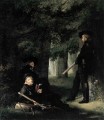Artists
Georg Friedrich Kersting
- Country:
- Germany
- Birth year:
- 1785
- Death year:
- 1847
Beginning in 1805, Georg Rriedrich Kersting (1785 Gustrow-1847 Meissen) attended the art academies of Copenhagen and Dresden, and in 1810 he accompanied Caspar David Friedrich on a walking tour through the Riesengebirge in eastern Germany. In 1812/13 the patriotic young artist applied for military service and entered the Lutzow Corps as a volunteer. Starting in 1616 he worked in Warsaw, and was the drawing teacher of Princess Sophia. Two years later he went to Meissen, where he took over the position of director of the painting department in the porcelain factory there. Aside from short journeys to Berlin (1822,1844), Weimar (1824), Nuremburg and Dresden, he remained in Meissen for the rest of is life. Kersting's paintings, primarily small-format portraits set in genre-like domestic surroundings, were highly praised by Goethe. His surviving works include drawings and watercolors, and include Man at a Secretary, 1811, Scholobmuseum, Weimar; and the Violinist Nicolo Paganini, c. 1830, Gemaldegalerie Neue Meister, Dresden.





